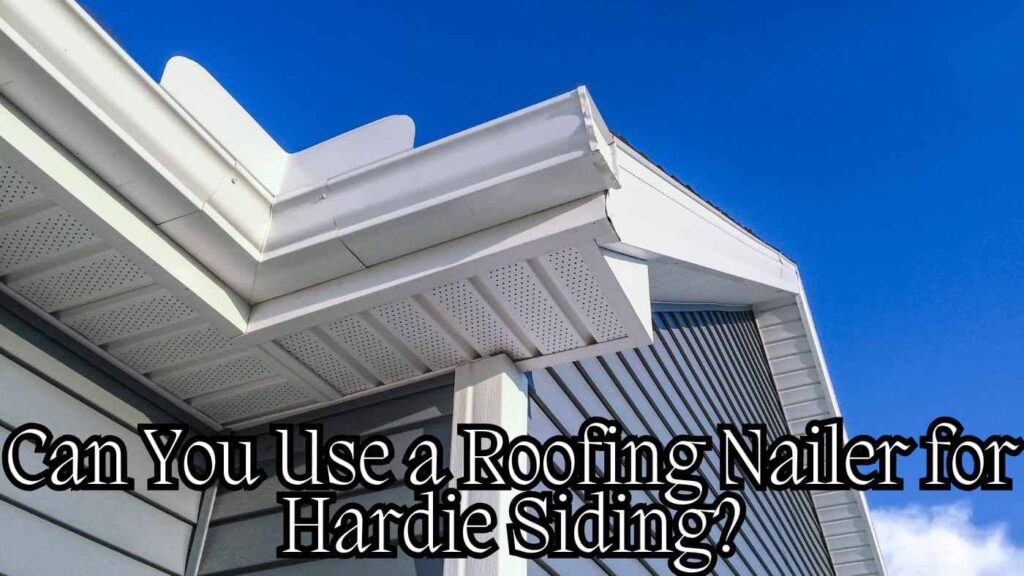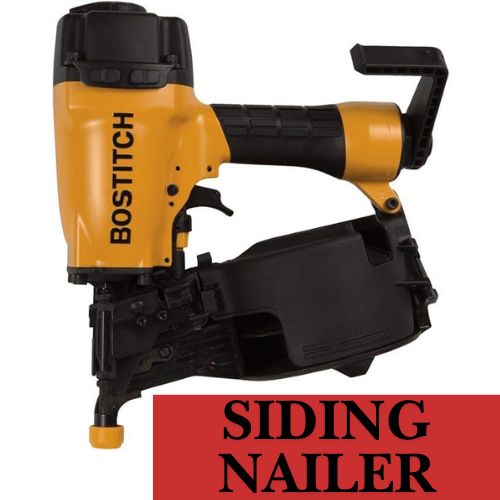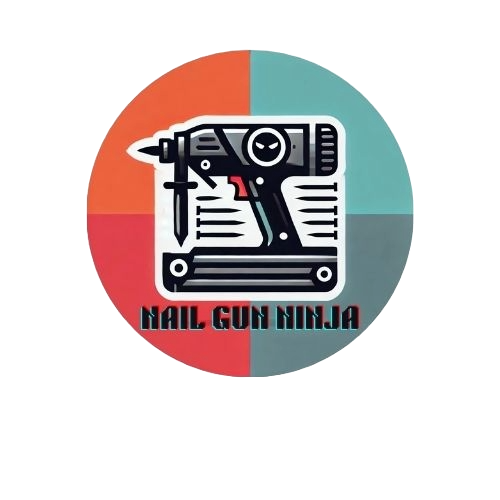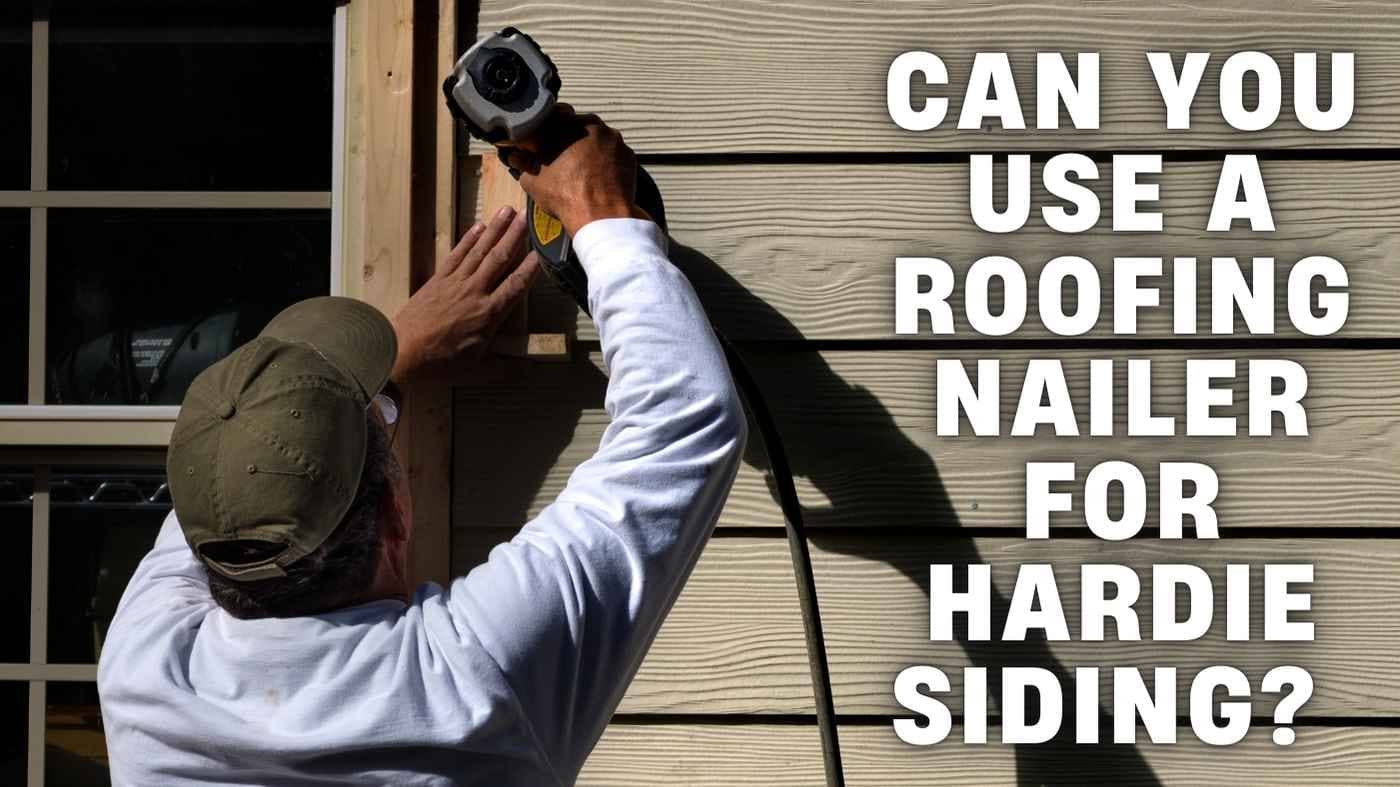Hardie siding is a popular material for home exteriors. It is strong and durable. Many people want to know if they can use a roofing nailer for Hardie siding.
Roofing nailers are made for roofing materials like shingles. They can be fast and efficient. But are they the right tool for Hardie siding? The answer is No. You can’t use a roofing nailer for hardie siding. But in the case of some lightweight siding works, you can use roofing nailers.
In this article, we will explore whether can you use a roofing nailer for hardie siding. We will explain the reasons behind it. Moreover, we will learn the risks and benefits. You will also learn about the tools that work best for this task.
Can You Use a Roofing Nailer for Hardie Siding?

Technically Possible, but Not Recommended
A roofing nailer can drive nails into Hardie siding. However, it is not the best tool for the job. It does not have the precision needed for proper installation. The risk of driving nails too deep or not deep enough is high.
Mismatch in Nail Type and Size
Roofing nails are usually too short. They also have wide heads. These nails are not made for fiber cement siding like Hardie. Using them can make the siding unstable and affect its appearance.
Depth Adjustment Challenges
Roofing nailers do not have fine depth control. Hardie siding requires exact nail depth. Without this control, the nails can damage the siding or fail to hold it securely.
Increased Risk of Material Cracking
Hardie siding is dense and requires careful nail placement.
The force from a roofing nailer can cause the siding to crack or split. This can reduce the effectiveness and lifespan of the material.
Potential to Void Manufacturer Warranty
James Hardie recommends using siding nailers or hand nailing for installation.
Using a roofing nailer may go against these guidelines. If you do this, you may lose the warranty on your siding.
Inefficiency in Precision Work
Installing Hardie siding requires precise nail placement. Roofing nailers are made to work fast, not accurately. This can make it hard to follow the required nailing patterns and spacing for Hardie siding.
Risks of Using a Roofing Nailer for Hardie Siding
Material Cracking
Roofing nailers use a lot of force. This can crack the fiber cement of Hardie siding, especially near the edges or corners.
Cracks can make the siding less strong. The siding can be damaged more easily by weather or physical impacts.
Risk of Nail Head Damage
The strong force of a roofing nailer can damage the nail heads. Damaged nail heads are not as effective at holding the siding in place. This can cause the siding to loosen or fall off over time.
Increased Risk of Siding Warping
If nails are not placed correctly, it can cause uneven pressure on the Hardie siding. This can increase the chance of the siding warping or bending.
This is especially true when the siding is exposed to heat or moisture.
Damage to Tools or Equipment
Roofing nailers are designed for softer materials like shingles. Using them on Hardie siding can cause the tool to wear out quickly.
Inefficient Installation Process
A roofing nailer may seem like a faster option, but it can lead to more mistakes. It may take longer to fix errors, like moving nails or replacing cracked boards. This can slow down the entire installation process.
Best Tools for Hardie Siding Installation
Siding Nailers

Siding nailers are made for fiber cement siding like Hardie. They allow you to adjust the depth of the nails precisely.
These tools can also handle the longer, corrosion-resistant nails needed for Hardie siding. Therefore, use siding nailers instead of roofing nailers.
Pneumatic Nailers
Pneumatic siding nailers give consistent power when driving nails into dense materials like Hardie boards. They help to make sure the nails go in correctly and reduce the chance of damaging the material.
Carbide Tipped Circular Saws
Carbide tipped circular saws are needed to cut Hardie siding cleanly. These saws have strong blades that prevent chipping. They also give precise cuts that help with tight joints.
Shears and Snips
Siding shears or snips are designed to make smooth, dust-free cuts. They are quieter than saws and are great for making small cuts or adjustments. They work well when cutting near edges.
Drills with Masonry Bits
A drill with masonry bits is used for pre-drilling holes near the edges of the siding. This helps avoid cracking, especially in areas that get a lot of stress.
Safety Gear
Cutting Hardie siding can create fine silica dust. This dust can be harmful. You need to wear safety gear such as dust masks, safety glasses, and ear protection to protect your health
Common Tools Should Not Use for Hardie Siding
Roofing Nailers
Roofing nailers are not made for Hardie siding. Hardie siding is dense and heavy, and roofing nailers lack the precision needed for the job.
They can cause nails to go too deep or too shallow. This can lead to cracks, overdriven nails, or damage to the material.
Framing Nailers
Framing nailers are powerful but are not suitable for siding. Their high power can cause damage to the siding, such as splitting the material. The nails can also go too deep, which makes them ineffective.
Regular Hammers
Using a standard hammer to nail Hardie siding can cause problems. The nails may not be placed properly.
The depth may also be wrong. The impact from the hammer can crack or chip the siding.
Cordless Drills
Cordless drills are good for driving screws, but they are not ideal for Hardie siding. When using standard bits, they can cause the screws to be too tight.
This can crack the material. Special masonry or fiber cement bits are needed to avoid these issues.
Circular Saws with Standard Blades
A regular circular saw with a standard blade should not be used to cut Hardie siding. The saw may cause the material to chip or crack.
Hardie siding requires a specialized, carbide tipped blade to prevent damage to the edges of the material.
Jigsaws
Jigsaws are useful for smaller projects but are not great for cutting Hardie siding. They tend to create rough edges, which can affect the finish.
They also produce a lot of dust, which can be harmful to health and make the worksite messy.
When to Use Roofing Nails for Hardies Siding (If Necessary)
Roofing nailers are not the best option for hardie siding. However, in an emergency, if you don’t have the required nail guns then you can use roofing nail guns as a temporary tool to do your job instantly.
In Emergency or Temporary Installations
A roofing nailer can be used in rare situations when a siding nailer is not available. This should only be a temporary solution. You should replace the roofing nailer with the right tool as soon as you can.
For Small, Non Structural Sections
A roofing nailer might be okay for small parts of Hardie siding that do not affect the structure. These sections do not need to last as long or look perfect.
However, you should still be careful to avoid damaging the material.
For Quick Fixes or Repairs
A roofing nailer can be used for quick, temporary repairs. For example, it can help reattach a loose piece of Hardie siding.
However, for full installation, you should switch to a siding nailer.
During Fast, Temporary Projects
If you are working on a temporary structure or a project that won’t be exposed to heavy wear you might use a roofing nailer. But it is not a good suggestion.
Conclusion
In conclusion, using a roofing nailer for Hardie siding is not a recommended option. Even more, if there are any all in one featured nail guns in the future, then it will be quite difficult.
Roofing nailers are designed for materials like shingles. They may cause damage to the dense and sturdy Hardie siding.
Furthermore, using a roofing nailer to install hardie siding can result in overdriven nails, cracks, or loose siding. It is always better to use the right tool, like a siding nailer, for the job.
A siding nailer will provide the precision needed to install Hardie siding properly. For the best results, use the tools recommended by the manufacturer.
FAQs
1. Can you use roofing nails for Hardie siding?
Ans: No, roofing nails are not good for Hardie siding. They are too short and have wide heads. These nails are not strong enough to hold fiber cement properly.
2. Can you nail Hardie siding by hammer?
Ans: Yes, you can. But it will take much longer and be harder. Manual nailing like hammering requires careful attention to nail depth and placement. So, use nail guns instead of hammers.
3. What is the best fastener for Hardie siding?
Ans: The best fasteners are galvanized or stainless steel nails. They should be 2 ½ to 3 inches long.
These nails do not rust, which helps the siding last longer. The nails should have a small head to hold the siding properly without damaging it.
4. Can you use screws instead of nails for Hardie siding?
Ans: Yes, you can use screws. But nails are usually better because they are faster to install. Screws can hold the siding tighter, especially in windy or harsh weather. If you use screws, make sure they are rust-resistant.
5. How far apart should nails be when installing Hardie siding?
Ans: Nails should be about 6 to 8 inches apart on the edges of the boards. This will keep the siding secure and prevent movement or damage over time.

